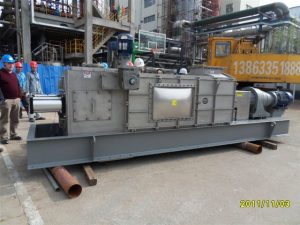The production of many food ingredients requires the separation of aqueous alcohol solution from the product. This is accomplished in a screw press of vapor tight construction. The design and construction of such presses is a specialty of Vincent Corporation of Tampa, Florida.
Machines used in potentially explosive atmospheres require careful consideration of safety factors. Use of explosion-proof motors and vapor-tight covers, as well as avoidance of belt drives, are obvious items. More importantly, the design must avoid the possibility of metal-on-metal rubbing. The European ATEX regulations are very demanding.
The final moisture content of the press cake is controlled by the air pressure on the discharge cone of the screw press. The discharge cone of modern Vincent presses is actuated by dual air cylinders. This design is especially good in vapor-tight applications as it puts the air cylinders and thrust bearing outside of the vapor-tight compartment.
The design of the covers for vapor-tight presses has been improved as a result of work with CP Kelco in Denmark. A 5/8″ by 1″ extrusion of EPDM is mounted in a pocket which follows the perimeter of the cover. The cover itself is a honey-comb structure that minimizes warpage. This simple design provides reliable sealing while greatly reducing the number of clamps required.
In some applications there is a need to strip the press cake away from the discharge. This is done by having the discharge cone rotate along with the screw of the press. A much-simplified mechanism is being used to drive the discharge cone when the rotating cone feature is specified. This has greatly reduced the cost of the option.
The key markets for vapor-tight screw presses include the production of pectin and soybean protein concentrate. Pectin is extracted from citrus peel, apple waste, as well as sugar beet pulp. Some work has been done with facilities producing Xanthan gum.
The trend is toward larger and larger screw presses. The traditional 16″ press, used for many decades, lost favor to the VP-22 for soybean applications at ADM in the 1990’s.
This same design was selected for citrus pectin production by CP Kelco in 2000. In 2005, 24″ presses were supplied to Danisco and a Chinese firm, for citrus and apple pectin respectively. More recently, Archer Daniels Midland has selected the 30″ press.
These presses are driven by VFD’s. Baldor and Siemens explosion-proof motors are now available that are rated for operation over an extremely wide range, 9 to 90 Hertz.

Issue 188
